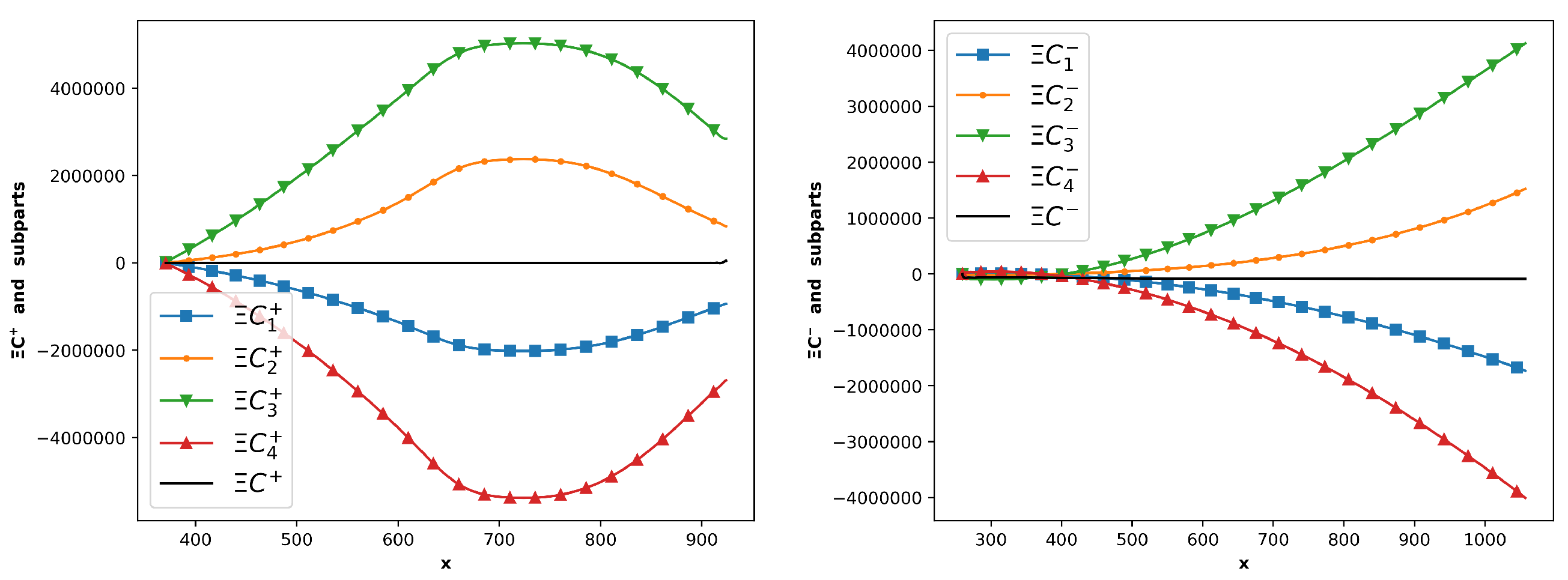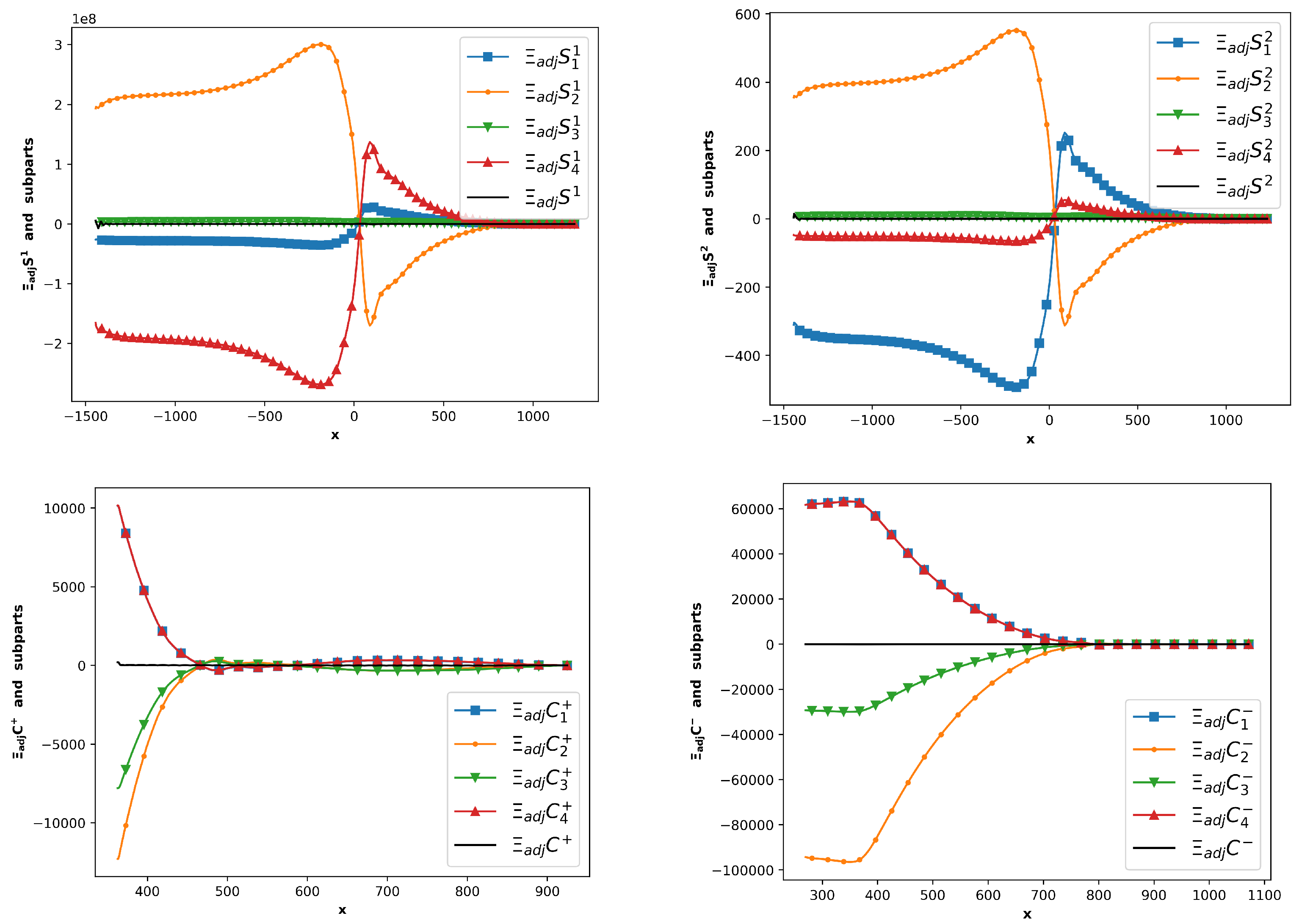Adjoint and Direct Characteristic Equations for Two-Dimensional Compressible Euler Flows
Abstract
:1. Introduction
2. Common Properties of Linear Systems for the Cauchy Direct and Adjoint Problems
2.1. Notation, Steady-State Euler Equations
2.2. Generic Cauchy Problem Embedding ACE and DCE Base Equations
2.3. Coefficients of ACE and DCE as Determinants
2.4. Number of independent CEs along the C and C
2.5. Nullity of All Minors along the S Curves
3. Derivation of Characteristic Equations for 2D Inviscid Compressible Flows Using Conservative Variables
3.1. Flow Properties, Sets of Variables, Resulting Equations for the Usual Derivation of the Characteristic Equations
3.2. Derivation of the Characteristic Equations in Conservative Variables
3.3. Ordinary Differential Equations along the Streamtraces S
3.4. Ordinary Differential Equations along the CC
4. Assessment of the Direct and Adjoint Characteristic Equations for a Nozzle Flow
4.1. Supersonic Nozzle Configuration
4.2. Flow Calculation, Flow Analysis
4.3. Thrust-Adjoint Calculation: Extraction of C and C Curves
4.4. Relation between the Adjoint Components of Density Equation and Total Energy Equation
4.5. Assessment of the DCEs
4.6. Assessment of the ACEs for the Thrust Adjoint
5. Conclusions
Supplementary Materials
Author Contributions
Funding
Data Availability Statement
Acknowledgments
Conflicts of Interest
Appendix A
Appendix B
Appendix C. Assessment of the Thrust Adjoint via a Shape Optimization



References
- Ferri, A. Application of the Method of Characteristics to Supersonic Rotational Flow; TR 841; NASA: Washington, DC, USA, 1946. [Google Scholar]
- Shapiro, A. The Dynamics and Thermodynamics of Compressible Fluid Flow; The Ronald Press Company: New York, NY, USA, 1954. [Google Scholar]
- Bonnet, A.; Luneau, J. Aérodynamique. Théories de la Dynamique des Fluides; Cepadues: Toulouse, France, 1989. [Google Scholar]
- Délery, J. Traité D’aérodynamique Compressible; Collection Mécanique des Fluides, Lavoisier—Hermés, Science: Cachan, France, 2008; Volume 3. [Google Scholar]
- Jameson, A. Aerodynamic design via control theory. J. Sci. Comput. 1988, 3, 233–260. [Google Scholar] [CrossRef]
- Brezillon, J.; Gauger, N. 2D and 3D Aerodynamic Shape Optimization Using the Adjoint Aproach. Aerosp. Sci. Technol. J. 2004, 8, 715–727. [Google Scholar] [CrossRef]
- Brezillon, T.; Dwight, R. Discrete adjoint of the Navier-Sotkes equations for aerodynamic shape optimization. In Proceedings of the EUROGEN 2005, Munich, Germany, 12–14 September 2005. [Google Scholar]
- Peter, J.; Dwight, R. Numerical sensitivity analysis for aerodynamic optimization: A survey of approaches. Comput. Fluids 2010, 39, 373–391. [Google Scholar] [CrossRef]
- Schmidt, S.; Ilic, C.; Schultz, V.; Gauger, N. Three dimensional large scale aerodynamic shape optimization based on shape calculus. AIAA J. 2013, 51, 2615–2627. [Google Scholar] [CrossRef]
- Venditti, D.; Darmofal, D. Grid adaptation for functional outputs: Application to two-dimensional inviscid flows. J. Comput. Phys. 2002, 176, 40–69. [Google Scholar] [CrossRef]
- Dwight, R. Heuristic a posteriori estimation of error due to dissipation in finite volume schemes and application to mesh adaptation. J. Comput. Phys. 2008, 227, 2845–2863. [Google Scholar] [CrossRef]
- Todarello, G.; Vonck, F.; Bourasseau, S.; Peter, J.; Désidéri, J.A. Finite-volume goal-oriented mesh-adaptation using functional derivative with respect to nodal coordinates. J. Comput. Phys. 2016, 313, 799–819. [Google Scholar] [CrossRef]
- Giles, M.; Duta, M.; Müller, J.D. Adjoint code developments using the exact discrete approach. In Proceedings of the 15th AIAA Computational Fluid Dynamics Conference, Anaheim, CA, USA, 11–14 June 2001. AIAA Paper Series, Paper 2001-2596. [Google Scholar]
- Giles, M.; Duta, M.; Müller, J.D.; Pierce, N. Algorithm developments for discrete adjoint methods. AIAA J. 2003, 41, 198–205. [Google Scholar] [CrossRef]
- Economon, T.; Alonso, J.; Albring, T.; Gauger, N. Adjoint Formulation Investigations of Benchmark Aerodynamic Design Cases in SU2. In Proceedings of the 35th AIAA Applied Aerodynamics Conference, Denver, CO, USA, 5–9 June 2017. AIAA Paper Series, Paper 2017-4363. [Google Scholar]
- Sagebaum, M.; Albring, T.; Gauger, N. High-Performance Derivative Computations using CoDiPack. ACM Trans. Math. Softw. 2019, 45, 1–26. [Google Scholar] [CrossRef]
- Pinel, X.; Montagnac, M. Block Krylov methods to solve adjoint problems in aerodynamic design optimization. AIAA J. 2013, 51, 2183–2189. [Google Scholar] [CrossRef]
- Xu, S.; Radford, D.; Meyer, M.; Müller, J.D. Stabilisation of discrete steady adjoint solvers. J. Comput. Phys. 2015, 299, 175–195. [Google Scholar] [CrossRef]
- Lions, J.L. Contrôle Optimal de Systèmes Gouvernés par des Équations aux Derivées Partielles; Etudes Mathématiques; Dunod, Gauthier-Villars: Paris, France, 1968. [Google Scholar]
- Sartor, F.; Mettot, C.; Sipp, D. Stability, Receptivity, and Sensitivity Analyses of Buffeting Transonic Flow over a Profile. AIAA J. 2015, 53, 1980–1993. [Google Scholar] [CrossRef]
- Laurenceau, J. Surfaces de réponses par Krigeage pour l’optimisation de formes. Ph.D. Thesis, Institut National Polytechnique de Toulouse, Toulouse, France, 2008. [Google Scholar]
- de Baar, J.; Scholcz, T.; Dwight, R. Technical Note: Exploiting Adjoint Derivatives in High-Dimensional Metamodels. AIAA J. 2015, 53, 1391–1395. [Google Scholar] [CrossRef]
- Sipp, D.; Marquet, O.; Meliga, P.; Barbagallo, A. Dynamics and Control of Global Instabilities in Open-Flows: A Linearized Approach. Appl. Mech. Rev. 2010, 63, 030801. [Google Scholar] [CrossRef]
- Luchini, P.; Bottaro, A. Adjoint Equations in Stability Analysis. Annu. Rev. Fluid Mech. 2014, 46, 493–517. [Google Scholar] [CrossRef]
- Parish, E.; Duraisamy, K. A paradigm for data-driven predictive modeling using field inversion and machine learning. J. Comput. Phys. 2016, 305, 758–774. [Google Scholar] [CrossRef]
- Talagrand, O.; Courtier, P. Variational Assimilation of Meteorological Observations With the Adjoint Vorticity Equation. I: Theory. Q. J. R. Meteorol. Soc. 1987, 113, 1311–1328. [Google Scholar] [CrossRef]
- Hirsch, C. Numerical Computation of Internal and External Flows: The Fundamentals of Computational Fluid Dynamics, 2nd ed.; Butterworth—Heineman; Elsevier: Amsterdam, The Netherlands, 2007. [Google Scholar]
- Anderson, W.; Venkatakrishnan, V. Adjoint design optimization on unstructured grid using a continuous adjoint formulation. Comput. Fluids 1999, 28, 443–480. [Google Scholar] [CrossRef]
- Giles, M.; Pierce, N. Analytic adjoint solutions for the quasi-one-dimensional Euler equations. J. Fluid Mech. 2001, 426, 327–345. [Google Scholar] [CrossRef]
- Peter, J.; Désidéri, J.A. Ordinary differential equations for the adjoint Euler equations. Phys. Fluids 2022, 34, 086113. [Google Scholar] [CrossRef]
- Meyer, R.; Goldstein, S. The method of characteristics for problems of compressible flow involving two independant variables: Part I. The general theory. Q. J. Mech. Appl. Math. 1948, 1, 196–219. [Google Scholar] [CrossRef]
- Anderson, J. Modern Compressible Flow, 3rd ed.; McGraw-Hill Series in Aernautical and Aerospace Engineering; McGraw-Hill: New York, NY, USA, 2003. [Google Scholar]
- Oberkampf, W.; Trucano, T. Verification and validation in computational fluid dynamics. Prog. Aerosp. Sci. 2002, 38, 209–272. [Google Scholar] [CrossRef]
- Liepmann, H.; Roshko, A. Elements of Gasdynamics; Dover Publications: Mineola, NY, USA, 1956. [Google Scholar]
- Grossman, B. Fundamental Concepts of Real Gasdynamics; Virginia Polytechnic Institute and State University: Blacksburg, VA, USA, 2000. [Google Scholar]
- Mourouzidis, C. Preliminary Design of Next Generation Mach 1.6 Supersonic Business Jets to Investigate Landing and Take-Off (LTO) Noise and Emissions. In Proceedings of the 12th EASN conference on Innovation and Space for opening New Horizons, Barcelona, Spain, 18–21 October 2022. [Google Scholar]
- Cambier, L.; Heib, S.; Plot, S. The elsA CFD software: Input from research and feedback from industry. Mech. Ind. 2013, 14, 159–174. [Google Scholar] [CrossRef]
- Jameson, A.; Schmidt, W.; Turkel, E. Numerical Solutions of the Euler Equations by Finite Volume Methods Using Runge-Kutta Time-Stepping Schemes. In Proceedings of the 14th Fluid and Plasma Dynamics Conference, Palo Alto, CA, USA, 23–25 June 1981. AIAA Paper Series, Paper 1981-1259. [Google Scholar]
- Peter, J.; Renac, F.; Dumont, A.; Méheut, M. Discrete adjoint method for shape optimization and mesh adaptation in the elsA code. In Status and Challenges. In Proceedings of the 50th 3AF Symposium on Applied Aerodynamics, Toulouse, France, 29 March–1 April 2015. [Google Scholar]
- Peter, J.; Renac, F.; Labbé, C. Analysis of finite-volume discrete adjoint fields for two-dimensional compressible Euler flows. J. Comput. Phys. 2022, 449, 110811. [Google Scholar] [CrossRef]
- Giles, M.; Pierce, N. Adjoint equations in CFD: Duality, boundary conditions and solution behaviour. In Proceedings of the 13th Computational Fluid Dynamics Conference, Snowmass Village, CO, USA, 29 June–2 July 1997. AIAA Paper Series, Paper 97-1850. [Google Scholar]
- Lozano, C. On mesh sensitivities and boundary formulas for discrete adjoint-based gradients in inviscid aerodynamic shape optimization. J. Comput. Phys. 2017, 346, 403–436. [Google Scholar] [CrossRef]
- Lozano, C. Singular and discontinuous solutions of the adjoint Euler equations. AIAA J. 2018, 56, 4437–4451. [Google Scholar] [CrossRef]
- Lozano, C. Watch your adjoints! Lack of mesh convergence in inviscid adjoint solutions. AIAA J. 2019, 57, 3991–4006. [Google Scholar] [CrossRef]
- Peter, J. Contributions to Discrete Adjoint Method in Aerodynamics for Shape Optimization and Goal-Oriented Mesh Adaptation; University of Nantes. Mémoire pour Habilitation à Diriger des Recherches: Nantes, France, 2020. [Google Scholar]








Disclaimer/Publisher’s Note: The statements, opinions and data contained in all publications are solely those of the individual author(s) and contributor(s) and not of MDPI and/or the editor(s). MDPI and/or the editor(s) disclaim responsibility for any injury to people or property resulting from any ideas, methods, instructions or products referred to in the content. |
© 2023 by the authors. Licensee MDPI, Basel, Switzerland. This article is an open access article distributed under the terms and conditions of the Creative Commons Attribution (CC BY) license (https://creativecommons.org/licenses/by/4.0/).
Share and Cite
Ancourt, K.; Peter, J.; Atinault, O. Adjoint and Direct Characteristic Equations for Two-Dimensional Compressible Euler Flows. Aerospace 2023, 10, 797. https://doi.org/10.3390/aerospace10090797
Ancourt K, Peter J, Atinault O. Adjoint and Direct Characteristic Equations for Two-Dimensional Compressible Euler Flows. Aerospace. 2023; 10(9):797. https://doi.org/10.3390/aerospace10090797
Chicago/Turabian StyleAncourt, Kevin, Jacques Peter, and Olivier Atinault. 2023. "Adjoint and Direct Characteristic Equations for Two-Dimensional Compressible Euler Flows" Aerospace 10, no. 9: 797. https://doi.org/10.3390/aerospace10090797




